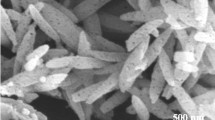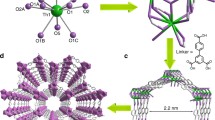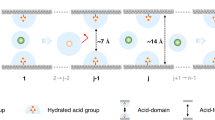Abstract
An anionic metal organic framework (Me2NH2)2[In2(H4TTBA)2](DMF)(H2O)15 (In-MOF-1; H4TTBA = 2′-amino-[1,1′:4′,1″-terphenyl]-3,3″,5,5″-tetracarboxylic acid, DMF = N,N-dimethylformamide) with suitable channels and PtS-type topology was synthesized and characterized. In-MOF-1 has three types of channels along a, b, c axis that displays the adsorption and selective separation ability toward the low concentration of small cationic dye molecules from water solution at room temperature.






Similar content being viewed by others
References
Armaghan M, Niu RJ, Liu Y, Zhang WH, Andy Hor TS, Lang JP (2018) Zn-based metal–organic frameworks (MOFs) of pyridinemethanol-carboxylate conjugated ligands: deprotonation-dependent structures and CO2 adsorption. Polyhedron 153:218–225. https://doi.org/10.1016/j.poly.2018.07.029
Avci C, Imaz I, Carné-Sánchez A, Pariente JA, Tasios N, Pérez-Carvajal J, Alonso MI, Blanco A, Dijkstra M, López C, Maspoch D (2018) Self-assembly of polyhedral metal–organic framework particles into three-dimensional ordered superstructures. Nat Chem 10:78–84. https://doi.org/10.1038/nchem.2875
Cai G, Jiang HL (2017) A Modulator-induced defect-formation strategy to hierarchically porous metal-organic frameworks with high stability. Angew Chem Int Edit 56:563–567. https://doi.org/10.1002/anie.201610914
Campbell S, Bernard FL, Rodrigues DM, Rojas MF, Carreño LÁ, Chaban VV, Einloft S (2019) Performance of metal-functionalized rice husk cellulose for CO2 sorption and CO2/N2 separation. Fuel 239:737–746. https://doi.org/10.1016/j.fuel.2018.11.078
Cao L, Lin Z, Shi W, Wang Z, Zhang C, Hu X, Wang C, Lin W (2017) Exciton migration and amplified quenching on two-dimensional metal–organic layers. J Am Chem Soc 139:7020–7029. https://doi.org/10.1021/jacs.7b02470
Cui Z, Zhang XY, Liu S, Zhou L, Lian Li WL, Zhang JP (2018) Anionic lanthanide metal–organic frameworks: selective separation of cationic dyes, solvatochromic behavior, and luminescent sensing of Co(II) ion. Inorg Chem 57:11463–11473. https://doi.org/10.1021/acs.inorgchem.8b01319
Deng SQ, Mo XJ, Zheng SR, Jin X, Gao Y, Cai SL, Fan J, Zhang WG (2019) Hydrolytically stable nanotubular cationic metal–organic framework for rapid and efficient removal of toxic oxo-anions and dyes from water. Inorg Chem 58:2899–2909. https://doi.org/10.1021/acs.inorgchem.9b00104
Duan X, Lv R, Li S, Tang J, Ge J, Zhao D (2019a) Two –COOH decorated anionic metal–organic frameworks with open Cu2+ sites afforded highly C2H2/CO2 and C2H2/CH4 separation and removal of organic dyes. Z Anorg Allg Chem 645:955–959. https://doi.org/10.1002/zaac.201900111
Duan X, Lv R, Shi Z, Wang C, Li H, Ge J, Ji Z, Yang Y, Li B, Qian G (2019b) A new metal-organic framework with suitable pore size and ttd-type topology revealing highly selective adsorption and separation of organic dyes. J Solid State Chem 277:159–162. https://doi.org/10.1016/j.jssc.2019.06.012
Gao W, Liu F, Pan CW, Zhang XM, Liu JP, Gao QY (2019) A stable anionic metal–organic framework with open coordinated sites: selective separation toward cationic dyes and sensing properties. CrystEngComm 21:1159–1167. https://doi.org/10.1039/C8CE02060D
Gu ZG, Li DJ, Zheng C, Kang Y, Wöll C, Zhang J (2017) MOF-templated synthesis of ultrasmall photoluminescent carbon-nanodot arrays for optical applications. Angew Chem Int Edit 56:6853–6859. https://doi.org/10.1002/anie.201702162
He Y, Chen F, Li B, Qian G, Zhou W, Chen B (2018) Porous metal–organic frameworks for fuel storage. Coordin Chem Rev 373:167–198. https://doi.org/10.1016/j.ccr.2017.10.002
Hu LX, Deng GH, Lu WC, Pang SW, Hu X (2017) Deposition of CdS nanoparticles on MIL-53(Fe) metal-organic framework with enhanced photocatalytic degradation of RhB under visible light irradiation. Appl Surf Sci 410:401–413. https://doi.org/10.1016/j.apsusc.2017.03.140
Jiang K, Zhang L, Hu Q, Zhang Q, Lin W, Cui Y, Yang Y, Qian G (2017) Thermal stimuli-triggered drug release from a biocompatible porous metal–organic framework. Chem Eur J 23:10215–10221. https://doi.org/10.1002/chem.201701904
Kahn JS, Freage L, Enkin N, Garcia MAA, Willner I (2017) Stimuli-responsive DNA-functionalized metal-organic frameworks (MOFs). Adv Mater 29:1602782. https://doi.org/10.1002/adma.201602782
Kan L, Cai J, Jin Z, Li G, Liu Y, Xu L (2019) Two stable Zn-cluster-based metal–organic frameworks with breathing behavior: synthesis, structure, and adsorption properties. Inorg Chem 58:91–396. https://doi.org/10.1021/acs.inorgchem.8b02507
Kausar A, Iqbal M, Javed A, Aftab K, Nazli Z, Bhatti HN, Nouren SJ (2018) Dyes adsorption using clay and modified clay: a review. Mol Liq 256:395–407. https://doi.org/10.1016/j.molliq.2018.02.034
Kyzas GZ, Deliyanni EA, Bikiaris DN, Mitropoulos AC (2018) Graphene composites as dye adsorbents: review. Chem Eng Res Des 129:75–88. https://doi.org/10.1016/j.cherd.2017.11.006
Lan G, Ni K, Veroneau SS, Song Y, Lin W (2018) Nanoscale metal–organic layers for radiotherapy–radiodynamic therapy. J Am Chem Soc 140:16971–16975. https://doi.org/10.1021/jacs.8b11593
Li P, Vermeulen NA, Malliakas CD, Gómez-Gualdrón DA, Howarth AJ, Mehdi BL, Dohnalkova A, Browning ND, O’Keeffe M, Farha OK (2017) Bottom-up construction of a superstructure in a porous uranium-organic crystal. Science 356:624–627. https://doi.org/10.1126/science.aam7851
Li B, Wen HM, Yu Y, Cui Y, Zhou W, Chen B, Qian G (2018) Nanospace within metal–organic frameworks for gas storage and separation. Mater Today Nano 2:21–49. https://doi.org/10.1016/j.mtnano.2018.09.003
Lin RB, Xiang S, Li B, Cui Y, Zhou W, Qian G, Chen B (2018) Reticular Chemistry of Multifunctional Metal-Organic Framework Materials. Z Anorg Allg Chem 58:949–961. https://doi.org/10.1002/ijch.201800054
Liu Y, Howarth AJ, Hupp JT, Farha OK (2015) Selective photooxidation of a mustard-gas simulant catalyzed by a porphyrinic metal-organic framework. Angew Chem Int Edit 127:9129–9133. https://doi.org/10.1002/anie.201503741
Liu X, Xiao Z, Xu J, Xu W, Sang P, Zhao L, Zhu H, Sun D, Guo W (2016) A NbO-type copper metal–organic framework decorated with carboxylate groups exhibiting highly selective CO2 adsorption and separation of organic dyes. J Mater Chem A 4:13844–13851. https://doi.org/10.1039/C6TA02908F
Liu W, Huang J, Yang Q, Wang S, Sun X, Zhang W, Liu J, Huo F (2017) Multi-shelled hollow metal-organic frameworks. Angew Chem 129:5604–5608. https://doi.org/10.1002/anie.201701604
Liu J, Wei Y, Bao F, Li G, Liu H, Wang H (2019) Pore-size tuning in pillared-layer metal–organic framework with self-penetrated rob net for selective gas adsorption and efficient dyes adsorption in aqueous solution. Polyhedron 169:58–65. https://doi.org/10.1016/j.poly.2019.05.003
Manna K, Ji P, Greene FX, Lin W (2016) Metal–organic framework nodes support single-site magnesium-alkyl catalysts for hydroboration and hydroamination reactions. J Am Chem Soc 138:7488–7491. https://doi.org/10.1021/jacs.6b03689
Marshall RJ, Kalinovskyy Y, Griffin SL, Wilson C, Blight BA, Forgan RS (2017) Functional versatility of a series of Zr metal-organic frameworks probed by solid-state photoluminescence spectroscopy. J Am Chem Soc 139:6253–6260. https://doi.org/10.1021/jacs.7b02184
Medishetty R, Nalla V, Nemec L, Henke S, Mayer D, Sun H, Reuter K, Fischer RA (2017) A new class of lasing materials: intrinsic stimulated emission from nonlinear optically active metal-organic frameworks. Adv Mater 29:1605637. https://doi.org/10.1002/adma.201605637
Pan J, Zhang D, Shang MM, Mu Y, Han SD, Wang GM (2010) An anionic Cd-based coordination polymer exhibiting ion-exchange behavior for photoluminescence and selective dye adsorption. J Lumin 210:70–74. https://doi.org/10.1016/j.jlumin.2019.02.020
Rafatullah M, Sulaiman O, Hashim R, Ahmad A (2010) Adsorption of methylene blue on low-cost adsorbents: a review. J Hazard Mater 177:70–80. https://doi.org/10.1016/j.jhazmat.2009.12.047
Schoedel A, Li M, Li D, O’Keeffe M, Yagh OM (2016) Structures of metal–organic frameworks with rod secondary building units. Chem Rev 116:12466–12535. https://doi.org/10.1021/acs.chemrev.6b00346
Sharma K, Dalai AK, Vyas RK (2017) Removal of synthetic dyes from multicomponent industrial wastewaters. Rev Chem Eng 34:107–134. https://doi.org/10.1515/revce-2016-0042
Silva FC, Lima LCB, Bezerra RDS, Osajima JA, Silva Filho EC (2015) Use of cellulosic materials as dye adsorbents—a prospective study. Cellulose: 115-132. https://doi.org/10.5772/61343
Wang S, Wahiduzzaman M, Davis L, Tissot A, Shepard W, Marrot J, Martineau-Corcos C, Hamdane D, Maurin G, Devautour-Vinot S, Serre C (2018) A robust zirconium amino acid metal-organic framework for proton conduction. Nat Comm 9:4937. https://doi.org/10.1038/s41467-018-07414-4
Yang SF, Niu CG, Huang DW, Zhang H, Liang C, Zeng GM (2017) SrTiO3 nanocubes decorated with Ag/AgCl nanoparticles as photocatalysts with enhanced visible-light photocatalytic activity towards the degradation of dyes, phenol and bisphenol A. Environ Sci: Nano 4:585–595. https://doi.org/10.1039/C6EN00597G
Yuan S, Feng L, Wang K, Pang J, Bosch M, Lollar C, Sun Y, Qin J, Yang X, Zhang P, Wang Q, Zou L, Zhang Y, Zhang L, Fang Y, Li J, Zhou HC (2018) Stable metal–organic frameworks: stable metal-organic frameworks: design, synthesis, and applications. Adv Mater. https://doi.org/10.1002/adma.201870277
Zhang Q, Yu J, Cai J, Song R, Cui Y, Yang Y, Chen B, Qian G (2014) A porous metal–organic framework with –COOH groups for highly efficient pollutant removal. Chem Commun 50:14455–14458. https://doi.org/10.1039/C4CC06648K
Zhang K, Xie X, Li H, Gao J, Nie L, Pan Y, Xie J, Tian D, Liu W, Fan Q, Su H, Huang L, Huang W (2017) highly water-stable lanthanide-oxalate MOFs with remarkable proton conductivity and tunable luminescence. Adv Mater 29:1701804. https://doi.org/10.1002/adma.201701804
Zhang Q, Cui Y, Qian G (2019a) Goal-directed design of metal-organic frameworks for liquid-phase adsorption and separation. Coordin Chem Rev 378:310–332. https://doi.org/10.1016/j.ccr.2017.10.028
Zhang Q, Wahiduzzaman M, Wang S, Henfling S, Ayoub N, Gkaniatsou E, Nouar F, Sicard C, Martineau C, Cui Y, Maurin G, Qian G, Serre C (2019b) Multivariable sieving and hierarchical recognition for organic toxics in nonhomogeneous channel of MOFs. Chem 5:1337–1350. https://doi.org/10.1016/j.chempr.2019.03.024
Zhao Y, Wang L, Fan N, Han M, Yang G, Ma L (2018) Porous Zn(II)-based metal–organic frameworks decorated with carboxylate groups exhibiting high gas adsorption and separation of organic dyes. Cryst Growth Des 18:7114–7121. https://doi.org/10.1021/acs.cgd.8b01290
Zhao D, Yu C, Jiang J, Duan X, Zhang L, Jiang K, Qian G (2019) A fluorinated Zr-based MOF of high porosity for high CH4 storage. J Solid State Chem 277:139–142. https://doi.org/10.1016/j.jssc.2019.05.051
Zhou Y, Qin L, Wu M, Han L (2018) A bifunctional anionic metal–organic framework: reversible photochromism and selective adsorption of methylene blue. Cryst Growth Des 18:5738–5744. https://doi.org/10.1021/acs.cgd.8b00895
Acknowledgements
The authors gratefully acknowledge financial support from National Natural Science Foundation of China (Nos. 51602087, 51702073), Zhejiang Provincial Natural Science Foundation of China (No. LY19E020010).
Author information
Authors and Affiliations
Corresponding author
Additional information
Publisher's Note
Springer Nature remains neutral with regard to jurisdictional claims in published maps and institutional affiliations.
Electronic supplementary material
Below is the link to the electronic supplementary material.
Rights and permissions
About this article
Cite this article
Duan, X., Shi, Z., Wang, C. et al. A new anionic metal–organic framework with suitable pore and PtS-type topology for selective adsorption and separation of cationic dyes. Chem. Pap. 74, 4003–4008 (2020). https://doi.org/10.1007/s11696-020-01209-y
Received:
Accepted:
Published:
Issue Date:
DOI: https://doi.org/10.1007/s11696-020-01209-y




